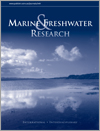Max Finlayson
Siobhan Fennessy
Patrick Grillas
Ritesh Kumar

Marine and Freshwater Research
Volume 74 Number 3 2023
Special IssueCommemorating the 50th Anniversary of the Ramsar Convention on Wetlands – Part 2
Coastal landscapes that have been drained for agriculture or other land-uses may provide additional blue carbon storage and sequestration if tides are restored. Potential blue carbon services were mapped across NSW coastal landscapes and maps identified more blue carbon opportunities in northern NSW than southern NSW. Blue carbon services above instream barriers were identified and prioritised for restoration. Restoration may be achieved using carbon market methodologies, such as Australia’s Emissions Reduction Fund, and restoration will serve to provide multiple co-benefits.
MF22014 Abstract | MF22014 Full Text | MF22014PDF (5.8 MB) | MF22014Supplementary Material (1.2 MB) Open Access Article
The Lake Eyre Basin is one of the world’s largest free-flowing rivers, largely unaffected by dams and river regulation. We overlayed the distribution of oil and gas production wells and infrastructure across the floodplains to assess potential impacts on the system’s freshwater ecosystems. We also examined the distribution of potential future developments, likely to be unconventional gas production, with more serious environmental impacts.
MF22063 Abstract | MF22063 Full Text | MF22063PDF (6 MB) | MF22063Supplementary Material (696 KB) Open Access Article
Research on bird trends is useful for measuring biodiversity changes. We analysed historical trends of bird species to estimate their abundance and assess the changes in communities. We found that land-use changes shaped the local bird community, with a decline in agricultural and grassland bird species. Coastal wetland and marine birds have increased, most probably being linked to the extension of saltpans and conservation measures. This approach can be replicated to identify priorities and to improve site conservation.
The focus of the present study is on the factors contributing to the vulnerability of coastal ecosystems, taking the example of Pulicat lagoon, south-eastern India. The work presents the need to reconcile the preservation of unique ecosystem services in times of urbanisation through policy-led initiatives recognising the importance of use of nature-based solutions at the heart of the developmental activities.
Coastal bays have supported human communities for millennia. Their effective management and restoration remains a challenge, in part as a result of human impacts that occurred before scientific studies. This review examines the historical ecology of bays and the tools and techniques used to discover environmental change to support effective management and restoration.
MF22005 Abstract | MF22005 Full Text | MF22005PDF (1.4 MB) Open Access Article
In the Murray–Darling Basin, Australia, policy-makers have implemented a program that attempts to use environmental water more effectively, allowing more water to be allocated for human uses. This program must be rigorously evaluated to ensure that the environmental benefits are not overstated. We provide a critique of the legislated method for evaluation, highlighting flaws and recommending improvements.
MF22082 Abstract | MF22082 Full Text | MF22082PDF (1.5 MB) Open Access Article
Wetlands need to be considered in their landscape context, in context of relationships that people have with them, and how societies are organised around them. This perspective highlights relational values of wetlands, most often expressed by Indigenous and local communities, where attachments to places yield understandings and responsibilities for policy. (Warning: this article contains the name of deceased Aboriginal person.)
MF22018 Abstract | MF22018 Full Text | MF22018PDF (381 KB) Open Access Article
We produced a distribution map of wetlands in Argentina (WetCarto_AR) by integrating open data sources developed by national agencies for other purposes. Wetlands are concentrated towards the north-east but patchy mostly elsewhere. Wetlands cover 13.5% of mainland Argentina, a figure greatly underestimated by global wetland datasets. Our results stress the importance of local databases to map the known extent of wetlands, to feed or validate global models, all contributing to reduce the information gap on wetland distribution in South America.